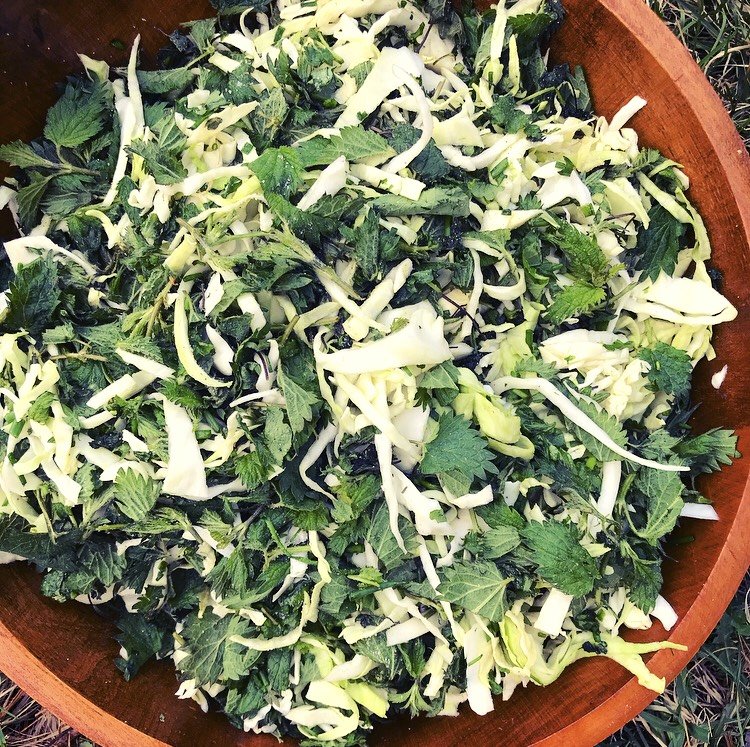Spring 'Kraut
Nettles (Urtica dioica)
When spring finally comes here in the northeast it can sometimes feel like a race against time. After waiting months for the return of the green, the plants seemingly pop-up all at once, with wonderful exuberance, and at a pace that few of us can keep up with. Harvesting spring greens- if you let it- could easily be a full-time job! And there’s not only the challenge of collecting all your favorites during their prime harvest windows, there’s also the challenge of preserving the spring harvest because it’s simply not always possible to eat all the greens at once!
Enter fermentation, a form of food preservation that was developed and utilized by our ancestors for just this situation. What I love about fermentation is that it’s living medicine, and while I love making wild salad, pesto, frittata, soup, vinegar, and more with the wild spring abundance, there’s something special about knowing that the food you’ve prepared is probiotic and teeming with beneficial microbes that we enter into a reciprocal relationship with when we take them into our bodies. Symbiosis is a beautiful thing! You can read more about the benefits of probiotic foods in my recipe for New England-Style Kimchi, and read-on for my recipe for preserving some of my favorite spring greens in a seasonal-inspired sauerkraut.
Spring ‘Kraut
9 cups cabbage, thinly shredded (about 1 medium-sized cabbage)
3 cups Nettles leaves and stems (Urtica dioica), coarsely chopped
3/4 cup Chives (Allium schoenoprasum), chopped
1/2 cup Garlic Mustard leaves and stems (Alliaria petiolata), coarsely chopped
4 tsp sea salt
other nice additions: Dandelion lvs, Wild Garlic (Allium vineale), Chickweed, Violet lvs, Yellow Dock lvs, Garlic lvs
First-off, this recipe is meant to be played around with. If you don’t have access to one of the greens in the recipe it’s ok to leave it out or substitute it for something you have an abundance of! Start by chopping your cabbage. Pile it into a big bowl and sprinkle with about 2 tsp of the salt and begin massaging it with your hands. The cabbage will begin to breakdown, releasing its juices which becomes the brine. Once the cabbage is thoroughly massaged start adding the Nettles bit by bit, along with the remaining salt, and keep massaging. You can wear gloves for this part if you’re worried about the sting (which will be rendered harmless by the fermentation process). Once you’ve added all the Nettles, add the Garlic Mustard and Chives and mix and massage thoroughly.
Next choose your vessel- a fermentation crock or widemouth mason jar will work. Pack the ‘kraut into your vessel and press in with your hands or use a sauerkraut stamper (also called a pounder or tamper) until the brine covers the ‘kraut. Use a heavy lid or small plate with a sterilized rock on it for the crock or mason jar to keep the brine levels over the veggies, or another good trick for this if you don’t have a small lid is to fill a ziplock bag with water and use that to keep ‘kraut below the brine level. Lastly, you can always make brine to top-off the sauerkraut by mixing 1 1/2 tbsp sea salt with 1 quart water. The bottom-line is that the brine level needs to be over the veggies. Now you sit back and let it ferment! Fermentation time will vary based on the weather, but start checking it after a few days to track its progression. It’s ready when it tastes sour, crunchy, and still salty, but not nearly as salty as it tasted when it first started fermenting. Then put it into a jar with a lid and keep in the fridge or your root cellar, if you’re lucky enough to have one! Enjoy as a condiment, with sandwiches, with breakfast, with a heavy meal, as a base for salad dressing, on a picnic, or even as a simple snack. Happy spring and happy fermenting!

